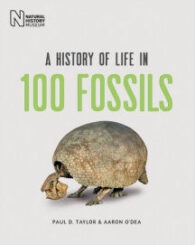By Paul D Taylor and Aaron O’Dea

I wouldn’t say I know Paul Taylor other than as an editor of his articles for Deposits magazine, but I did once go on a fieldtrip with him, organised by the Natural History Museum in London, more years ago than I care to remember.
It was to the Coralline Crag of Suffolk, which was chock full of bryozoans – Paul’s favourite fossil. And very interesting it was too – as was Paul. Therefore, I am not surprised how fascinating this book turns out to be.
A History of Life in 100 Fossils tells the story of life on earth using some of the most significant fossils ever found, which are kept at perhaps the two most preeminent natural history museums in the world – The Natural History Museum in London and the Smithsonian in Washington DC. It is set out in a simple format, in which (for the most part) one side of A4 of text describes a full page colour photograph of the fossil in question, displayed on the opposite page. Therefore, each fossil has a full A3 spread to itself.
Of course, the book could be read from cover to cover to discover how these remarkable fossil discoveries illustrate how life on earth has evolved. However, it could also be enjoyed by dipping in randomly, as each of the 100 sections are self-contained stories – whether about dinosaur teeth discovered in Sussex or Australopithecus skulls from South Africa. And each fossil is beautifully illustrated, with full colour photographs.
Paul Taylor is a stalwart of the NHM, currently a research scientist, but has worked there for over 35 years, including as head of the invertebrate and plant division between 1990 and 2003. Aaron O’Dea is a palaeobiologist at the Smithsonian, specialising in the processes that drive the evolution and construction of Caribbean reefs over geological time.
I wouldn’t buy this book if you want to identify your fossils. Those of us who like to collect can only dream, in our wildest fantasies, of finding anything like the fossils appearing in the excellent book (although, to be fair, I do have a few Gryphaeas and the odd Neptunea contraria). However, if you want to see how fossils have driven our understanding of life on earth, this one is for you.
There is now a follow up book, namely A History of Plants in 50 Fossils, which, as the name suggests, does a similar job to this one, but for plant fossils.
A History of Life in 100 Fossils, by Paul D Taylor and Aaron O’Dea, The Natural History Museum, London (2014), 224 pages (hardback), ISBN: 978-05-65093-47-1


